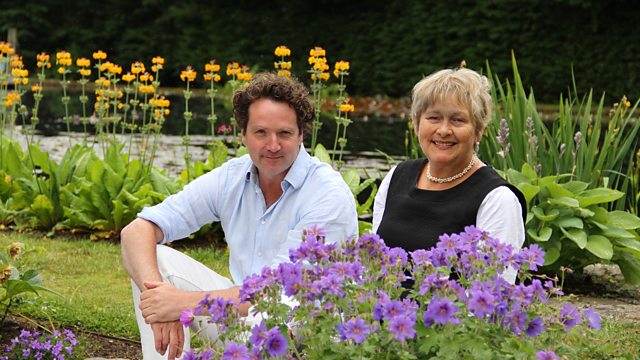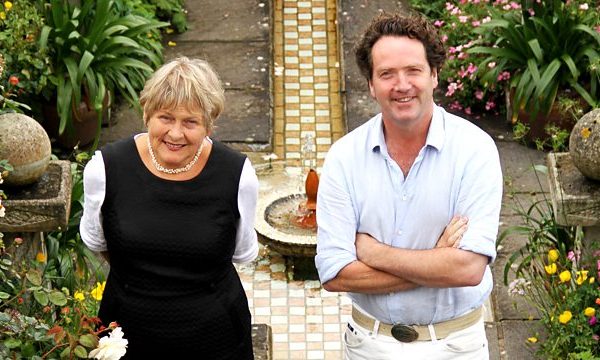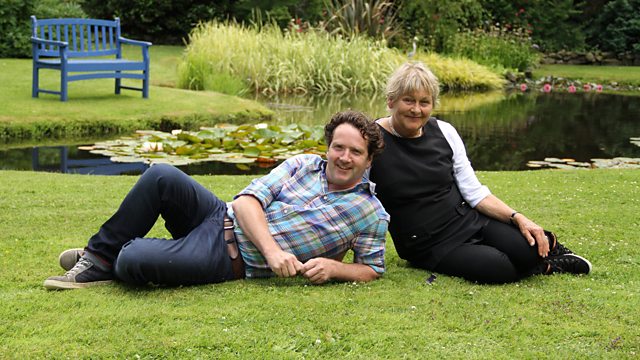In Alan Titchmarsh’s Gardening Club episode 8, viewers are in for a horticultural treat as an ensemble of gardening experts delves into a variety of fascinating topics and practical projects. This episode promises to inspire both novice and seasoned gardeners with its blend of expert advice, innovative ideas, and insightful explorations of gardening techniques and trends.
Kicking off the episode, Sarah Gerrard-Jones, a renowned houseplants expert, presents a captivating masterclass on creating terrariums. Terrariums, those miniature gardens enclosed in glass, are a perfect way to bring a touch of nature indoors, especially for those with limited outdoor space. Sarah walks viewers through the step-by-step process of designing and maintaining these self-contained ecosystems. From selecting the right container and choosing suitable plants to arranging decorative elements and ensuring proper care, Sarah’s tips are both practical and inspiring. Her expertise makes the complex art of terrarium-making accessible to everyone, adding a unique and verdant feature to any home.
Next, horticulturist David Domoney takes center stage with his project on creating a wildflower garden. Wildflower gardens are not only beautiful but also vital for supporting local wildlife, including pollinators like bees and butterflies. David demonstrates how to transform a section of a traditional garden into a vibrant, sustainable wildflower haven. He discusses the importance of selecting native species, preparing the soil, and sowing seeds to ensure a flourishing wildflower meadow. David’s enthusiasm and deep knowledge shine through as he explains how even small garden spaces can contribute to biodiversity and ecological balance.
Lucy Willcox then introduces the concept of garden zoning, an innovative approach to garden design that maximizes functionality and aesthetic appeal. Garden zoning involves dividing a garden into distinct areas, each serving a specific purpose, such as relaxation, dining, or cultivation. Lucy explores various zoning strategies, providing examples of how different elements—like plants, furniture, and pathways—can create harmonious and functional garden spaces. Her insights help viewers envision how they can reimagine their gardens to better suit their lifestyles and preferences, making outdoor spaces more enjoyable and efficient.
The episode also features a segment with Camilla Bassett-Smith, who takes a closer look at the inner workings of an acclaimed garden. Camilla visits a renowned garden, uncovering the design principles, plant selections, and maintenance practices that make it exceptional. She interviews the head gardener, delving into the challenges and triumphs of managing such a prestigious space. This segment offers viewers a behind-the-scenes glimpse into the dedication and creativity required to maintain a world-class garden, providing inspiration and ideas that can be applied to their own gardening endeavors.
Alan Titchmarsh’s Gardening Club Episode 8 – Alan Titchmarsh and His Expert Team
Throughout the episode, Alan Titchmarsh, the beloved gardening guru, ties everything together with his signature warmth and wisdom. Alan’s passion for gardening and his ability to connect with both experts and viewers make the show a delightful and informative experience. His interactions with the expert team add depth and context to each segment, ensuring that viewers gain a comprehensive understanding of the topics discussed.
The expert team accompanying Alan includes:
- David Domoney: Known for his dynamic approach to horticulture, David brings energy and expertise to every project he tackles. His wildflower garden initiative in this episode is a testament to his commitment to sustainable gardening practices.
- Camilla Bassett-Smith: With a keen eye for detail and a deep appreciation for garden design, Camilla’s explorations of acclaimed gardens offer viewers a wealth of inspiration and practical advice.
- Tayshan Hayden-Smith: A community gardener with a focus on urban gardening and social inclusion, Tayshan’s contributions highlight the importance of making gardening accessible to all, fostering a sense of community and connection through green spaces.
- Anna Greenland: An eco-friendly gardener, Anna advocates for organic gardening practices and sustainable living. Her insights help viewers understand how to garden in harmony with nature, promoting environmental stewardship.
- Sarah Gerrard-Jones: As a houseplant expert, Sarah’s terrarium masterclass is just one example of her ability to make indoor gardening both beautiful and manageable. Her knowledge of houseplants extends to creating lush, green interiors that enhance well-being.
A Wealth of Practical Gardening Tips
“Alan Titchmarsh’s Gardening Club” is more than just a show—it’s a treasure trove of practical gardening tips and creative ideas. Each episode, including this one, is designed to equip viewers with the knowledge and confidence to tackle their own gardening projects. Whether it’s learning how to create a thriving terrarium, transforming a patch of lawn into a wildflower meadow, or redesigning a garden for better functionality, the show offers something for everyone.
The episode concludes with a roundtable discussion where the experts share additional tips and answer viewer questions, creating an interactive and engaging experience. This collaborative approach ensures that the advice is comprehensive, addressing a wide range of gardening challenges and opportunities.
In summary, episode 8 of “Alan Titchmarsh’s Gardening Club” is a must-watch for anyone passionate about gardening. With its diverse array of topics and expert insights, it provides a rich source of inspiration and practical knowledge. Whether you’re an aspiring gardener or a seasoned pro, this episode has something to offer, helping you cultivate your green thumb and create beautiful, sustainable garden spaces.
Alan Titchmarsh’s Gardening Club Episode 8
Welcome to “Alan Titchmarsh’s Gardening Club,” brought to you by Green Thumb Lawn Treatment Service. In this new series, we celebrate the people, plants, and places that make gardening special across the UK. Join me, Alan Titchmarsh, in my own garden, where I’ll be swapping notes with my Gardening Club, joined by a passionate team of experts. We’ll also meet those at home and in the community who are breathing new life into forgotten spaces. Whether you have sprawling acres, a cosy balcony, or just a sunny windowsill, get ready to roll up your sleeves and dig in with us. Together, we’ll uncover tips, tricks, and techniques to transform our spaces into vibrant, thriving sanctuaries that nourish the soul and inspire the spirit. So pour yourself a cuppa and get comfy. Welcome to my Gardening Club.
Gardens across the UK are bursting with vibrancy and nose-tingling scents. Tulips, daffodils, and Japanese maples paint flower beds in a kaleidoscope of colours, while cherry blossom and magnolias add their own spectacle to the landscape. During spring, gardeners sow seeds for summer blooms and carefully nurture newly sprouted seedlings. With the lengthening days and brighter sunshine, there’s an unmistakable sense of anticipation in the air, heralding the arrival of summer and the promise of more garden delights.
On today’s show, we have a host of treats in store. Camilla Bassett-Smith takes us on a captivating journey through the world-famous Kew Gardens. Amateur gardener Alex shares the latest developments from his year of growing food in his garden, and David Domoney returns with his expert tips for creating a wildflower garden at home. But first, we’re joined by our resident houseplant expert, Sarah Gerrard-Jones, offering up a masterclass on terrariums.
Sarah Gerrard-Jones’ Terrarium Masterclass
Hi, I’m Sarah Gerrard-Jones, and today I’m going to show you how to make your very own terrarium. Terrariums are fully functioning ecosystems housed inside sealed glass containers where plants can live happily. To make a terrarium, you’ll need a glass container, some clay balls (also known as LECA), terrarium soil, a spray bottle, a brush, and small terrarium plants.
First, ensure that your glass container is completely clean and dry. Start by adding the clay balls at the bottom. These ensure oxygen circulates around the roots. Cover the bottom with clay balls, allowing enough depth for root growth. Next, add about two inches of terrarium soil and lightly moisten it with the spray bottle.
The types of plants you choose for a closed terrarium are important. They must be humidity-loving plants. Avoid cacti or succulents in a closed terrarium; they can be used in open ones. I’m using a small ficus plant and a pilia, which are ideal for terrariums. When placing the plants, avoid letting the leaves touch the glass to prevent rot from condensation. Use a brush to clean off any soil from the glass as you go along.
Adding moss to a terrarium makes it look more natural, like a miniature woodland floor. You can also divide plants like photonia into smaller parts to spread around the terrarium. Terrariums are a great project to do with children—they can add their favorite toys to create a miniature world.
Finally, clean the glass with a spray bottle and a soft cloth, close the lid, and find a spot in your house where the plants get enough light but not so much that they overheat. Creating a terrarium is magical, as it allows you to have a miniature ecosystem enclosed within glass.
Alex’s Year of Growing Food
Next up, we catch up with amateur gardener Alex, who has spent the past year growing as much veg as he could in his garden. His DIY approach and dedication are truly admirable.
Out in the garden, the sweet corn has started flowering, and the tomatoes have reached the height of the bamboo sticks, prompting Alex to cut the tops off to focus the plant’s energy on developing fruits. The onions planted as bulbs in March are now ready for harvest. A good sign is when the stem falls over, indicating the bulb has finished expanding. Alex stores the onions through a curing process, drying out the stems and outer layers in the greenhouse.
Despite the windy weather, Alex’s melons are growing well. He feeds them with tomato food high in potassium, essential for fruit development. While it’s a waiting game to see how many fruits become edible, the progress is promising.
In July, Alex had to lay down his vining melons due to their weight snapping the pins holding the string to the ceiling. Although one melon fell, he remains optimistic about the remaining ones. Despite facing challenges like onion white rot, Alex continues to persevere and learn.
David Domoney’s Wildflower Garden Tips
As we revel in the beauty of April’s blossoms, it’s the perfect time to think about bringing a touch of that natural splendor into our gardens. Creating a wildflower garden adds natural appeal to your outdoor space and provides vital habitats and food sources for pollinators like bees and butterflies.
David Domoney demonstrates how to grow a wildflower border in your backyard. The key is choosing the right spot with plenty of sunshine and ensuring it’s sheltered from strong winds. Understanding your soil type is crucial for selecting suitable seeds. David shows how to determine soil structure and recommends adding organic matter to improve soil health.
Once you’ve chosen your seeds, rake the soil surface to break up the crust, allowing the seeds to nestle in and absorb moisture. Mix the seeds with flour to see where you’ve sown them and ensure even coverage. Let nature do the rest, and as the sun warms the soil, the seeds will germinate, creating a lush, vibrant wildflower meadow.
Beth Bird’s Spring Gardening Tips
Plantfluencer Beth Bird from Yorkshire shares her favorite spring gardening tips for growing sweet peas and sunflowers. Soak sweet pea seeds for 24-48 hours to soften their shells, making it easier for seedlings to emerge. Use toilet roll tubes as pots, providing deep space for roots to grow. Once the seedlings are ready, plant the entire tube in the ground.
For sunflowers, place seeds with the pointed end facing down into pots or directly in the ground, covering with compost. Direct sowing tends to produce the best plants. Beth saves seeds from her tallest sunflowers each year, resulting in impressive eight-foot plants with numerous heads.
Lucy Wilcox on Garden Zoning
Garden designer Lucy Wilcox shares her expertise on zoning outdoor spaces. By dividing your garden into distinct areas, you can maximize its potential. Create a wish list of how you want to use your space, consider sun patterns, and choose appropriate spots for dining, seating, and intimate nooks. Use hard landscaping and planting beds to define zones and enhance the overall design.
Tayshan Hayden-Smith’s Gardening Tips
Community gardener Tayshan Hayden-Smith emphasizes the importance of observation and seeing all spaces as potential gardens. His favorite plant, the mimosa tree, resembles a firework. Tayshan suggests taking time to understand your surroundings and see opportunities for planting in any available space.
Ramona Jones’ Shady Border Masterclass
Ramona Jones demonstrates how to create a shady border in her cottage garden. Overcoming the challenge of overgrown and messy areas, she uses hydrangeas as a foundation, complemented by Japanese anemones and hellebores for seasonal interest. The transformation creates a diverse and vibrant shady border.
Camilla Bassett-Smith at Kew Gardens
Camilla Bassett-Smith explores Kew Gardens, renowned for its stunning plants and conservation efforts. Meeting with Kevin Martin, head of tree collections, she learns about the care and maintenance of Kew’s arboretum. The visit highlights Kew’s role in preserving rare and ancient trees and adapting to climate change.
F.A.Q. Gardening Club episode 8
Q.: What topics are covered in the latest episode of “Alan Titchmarsh’s Gardening Club”?
A.: The latest episode of “Alan Titchmarsh’s Gardening Club” covers a variety of gardening topics including terrarium creation, wildflower garden projects, garden zoning strategies, and an in-depth look at the inner workings of renowned gardens. Experts such as Sarah Gerrard-Jones, David Domoney, Lucy Willcox, and Camilla Bassett-Smith provide practical tips and innovative ideas to inspire gardeners of all levels.
Q.: How does Sarah Gerrard-Jones teach viewers to create a terrarium?
A.: Sarah Gerrard-Jones offers a step-by-step masterclass on creating terrariums. She explains how to select the right container and suitable plants, use clay balls for oxygen circulation, and properly layer terrarium soil. Sarah emphasizes the importance of choosing humidity-loving plants, arranging decorative elements, and maintaining the terrarium to create a self-contained ecosystem that adds a verdant touch to indoor spaces.
Q.: What are David Domoney’s tips for creating a wildflower garden?
A.: David Domoney provides comprehensive advice on transforming a section of a garden into a wildflower haven. He highlights the importance of selecting native species, preparing the soil, and choosing the right spot with plenty of sunshine. David also discusses the benefits of wildflower gardens for supporting local wildlife, including pollinators like bees and butterflies, and demonstrates how even small garden spaces can contribute to biodiversity.
Q.: What is garden zoning and how does Lucy Willcox suggest implementing it?
A.: Garden zoning is an approach to garden design that involves dividing a garden into distinct areas, each serving a specific purpose, such as relaxation, dining, or cultivation. Lucy Willcox suggests creating a wish list of desired uses for the garden, observing sun patterns, and strategically placing different zones. She also advises using plants, furniture, and pathways to define these zones, enhancing both functionality and aesthetic appeal.
Q.: What insights does Camilla Bassett-Smith provide from her visit to Kew Gardens?
A.: Camilla Bassett-Smith offers a fascinating look into Kew Gardens, focusing on the design principles, plant selections, and maintenance practices that make it a world-class garden. She interviews the head gardener, Kevin Martin, discussing the challenges and triumphs of managing such a prestigious space. The segment provides viewers with inspiration and ideas that can be applied to their own gardening endeavors, emphasizing the dedication and creativity required to maintain exceptional gardens.
Conclusion
“Alan Titchmarsh’s Gardening Club” offers a wealth of gardening knowledge and inspiration. From terrariums and wildflower gardens to zoning and shady borders, each segment provides valuable insights and practical tips. Whether you’re an experienced gardener or just starting, join us next time for more tips, tricks, and insights from our Gardening Club. Until then, enjoy your tulips and your garden.




